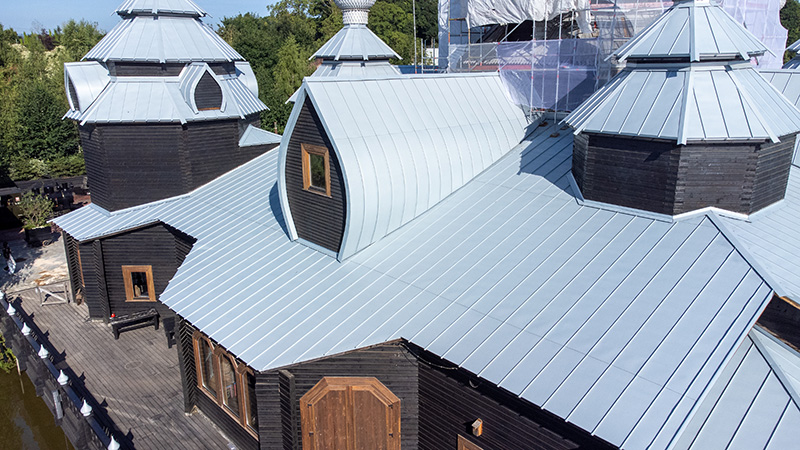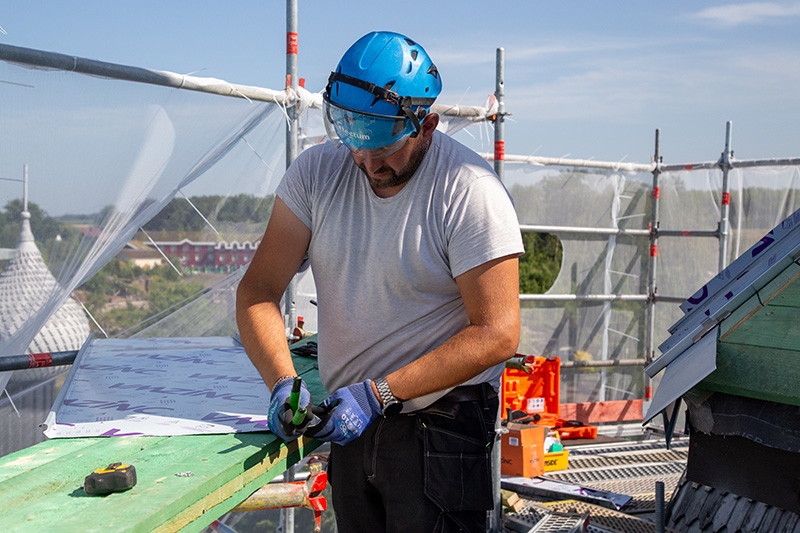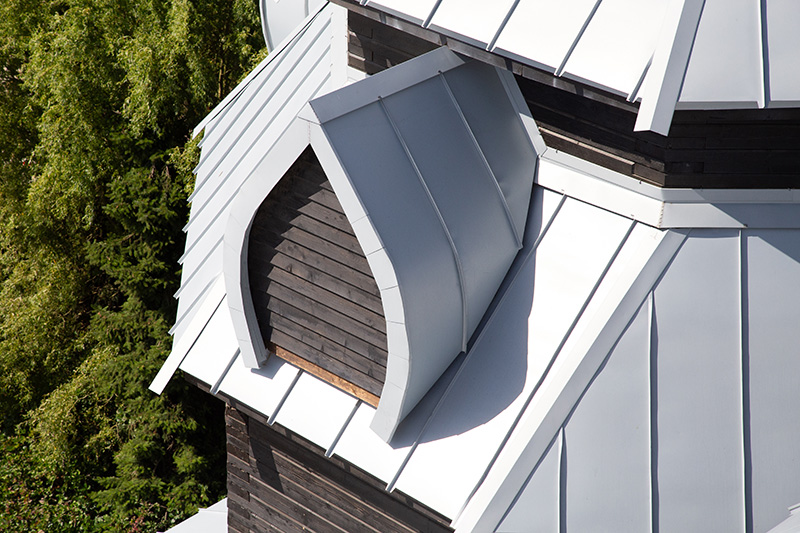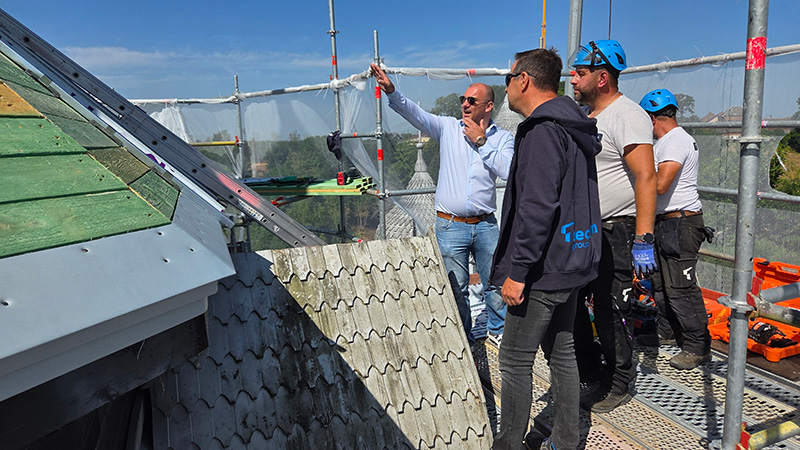
Anyone visiting the popular Pairi Daiza animal park this summer will not notice, but above the heads of hundreds of dining visitors a feat of artisanal craftsmanship is taking place. The roof of the Izba Restaurant, an impressive wooden structure with Eastern European inspiration, is getting a new zinc roofing. All while the restaurant remains open as usual. "We are working in a unique location, right in the heart of the park," laughs Geert Deboodt, site manager at Tectum Group. "But at the same time, this is one of the most technically challenging roofs I have ever worked on."
The roof of the Izba is not a simple plain, but a complex composition of turrets, angles and slopes. No two panels are the same. "Each panel is first measured and numbered on site, then custom-made in our workshop," says Deboodt. "On site itself, we cut cutouts and apply the final finishes. Because of the size of the roof, that numbering is essential."

For this project, Tectum Group is using Azengar zinc for the first time. The material has a rough, whitish surface that captures light in a special way. It gives the roof its distinctive look again, in a durable form.
"The original roof was beginning to lose its luster," says Quentin Bollens, project manager at Pairi Daiza. "We wanted to restore it while respecting the architecture, and the choice of a noble material such as zinc was natural."

The Izba is not a random restaurant. It is the first building erected in "The Land of the Cold," a themed area at Pairi Daiza dedicated to polar regions, northern Europe and Slavic cultures. "The inspiration for this building came from a trip Eric Domb, founder and CEO of Pairi Daiza, made in 2014 to the island of Kizji in Lake Onega," echoes the park. "There he found the wooden ensemble that would be the model for this restaurant."
An Izba is a traditional dwelling made of stacked tree trunks. "It's one of the most recognizable buildings in the park. Everyone passes by here, so the roof had to be in top shape again."

Anyone who thinks such a yard is easy to organize is mistaken. Pairi Daiza, with its 3.6 million visitors, is one of the country's most popular attractions. The Izba Restaurant is open daily and also plays an important role in the park's resort offerings. So closing is not an option.

"Time was our biggest challenge," says Bart Cannoot, project manager at Tectum Group. "We had six months from dismantling the roof to completion. At peak times, sixteen people were on the roof here at the same time: carpenters, zinc workers, installers."
The park cooperated with precise planning: deliveries are made before opening hours, the work zone is completely shielded and there are extra safety measures. "We even reversed the order of our works: normally you work from top to bottom, but here we started with the signage of the main roof, then the towers, and only at the end the zinc work on the main roof. Everything to guarantee the waterproofing."
Pairi Daiza was looking for a partner familiar with large complex roof structures in zinc. "Tectum Group was recommended to us by another partner of the park," says Quentin Bollens, project manager at Pairi Daiza. "When we saw their work on the Cinquantenaire Park site in Brussels, we knew they were up to the challenge. The collaboration has been particularly smooth, despite the demanding context in which to work."

The renovation of the Izba roof is part of a broader vision of the park to keep its infrastructure in top condition. It does so with sustainable materials and aesthetic care.
"It is one of those projects that we as a team are extremely proud of," said Kris Bloemen, CEO of Tectum Group. "The cooperation with Pairi Daiza has been extremely professional. Thanks to the flexibility of our people and good coordination with the park, we are bringing this prestigious project to a successful conclusion. Here we not only show our expertise in complex projects, but also how we, as a Limburg organization, are helping to write a story of national appeal. The special location makes it all the more valuable."

Anyone visiting the popular Pairi Daiza animal park this summer will not notice, but above the heads of hundreds of dining visitors a feat of artisanal craftsmanship is taking place. The roof of the Izba Restaurant, an impressive wooden structure with Eastern European inspiration, is getting a new zinc roofing. All while the restaurant remains open as usual. "We are working in a unique location, right in the heart of the park," laughs Geert Deboodt, site manager at Tectum Group. "But at the same time, this is one of the most technically challenging roofs I have ever worked on."
The roof of the Izba is not a simple plain, but a complex composition of turrets, angles and slopes. No two panels are the same. "Each panel is first measured and numbered on site, then custom-made in our workshop," says Deboodt. "On site itself, we cut cutouts and apply the final finishes. Because of the size of the roof, that numbering is essential."

For this project, Tectum Group is using Azengar zinc for the first time. The material has a rough, whitish surface that captures light in a special way. It gives the roof its distinctive look again, in a durable form.
"The original roof was beginning to lose its luster," says Quentin Bollens, project manager at Pairi Daiza. "We wanted to restore it while respecting the architecture, and the choice of a noble material such as zinc was natural."

The Izba is not a random restaurant. It is the first building erected in "The Land of the Cold," a themed area at Pairi Daiza dedicated to polar regions, northern Europe and Slavic cultures. "The inspiration for this building came from a trip Eric Domb, founder and CEO of Pairi Daiza, made in 2014 to the island of Kizji in Lake Onega," echoes the park. "There he found the wooden ensemble that would be the model for this restaurant."
An Izba is a traditional dwelling made of stacked tree trunks. "It's one of the most recognizable buildings in the park. Everyone passes by here, so the roof had to be in top shape again."

Anyone who thinks such a yard is easy to organize is mistaken. Pairi Daiza, with its 3.6 million visitors, is one of the country's most popular attractions. The Izba Restaurant is open daily and also plays an important role in the park's resort offerings. So closing is not an option.

"Time was our biggest challenge," says Bart Cannoot, project manager at Tectum Group. "We had six months from dismantling the roof to completion. At peak times, sixteen people were on the roof here at the same time: carpenters, zinc workers, installers."
The park cooperated with precise planning: deliveries are made before opening hours, the work zone is completely shielded and there are extra safety measures. "We even reversed the order of our works: normally you work from top to bottom, but here we started with the signage of the main roof, then the towers, and only at the end the zinc work on the main roof. Everything to guarantee the waterproofing."
Pairi Daiza was looking for a partner familiar with large complex roof structures in zinc. "Tectum Group was recommended to us by another partner of the park," says Quentin Bollens, project manager at Pairi Daiza. "When we saw their work on the Cinquantenaire Park site in Brussels, we knew they were up to the challenge. The collaboration has been particularly smooth, despite the demanding context in which to work."

The renovation of the Izba roof is part of a broader vision of the park to keep its infrastructure in top condition. It does so with sustainable materials and aesthetic care.
"It is one of those projects that we as a team are extremely proud of," said Kris Bloemen, CEO of Tectum Group. "The cooperation with Pairi Daiza has been extremely professional. Thanks to the flexibility of our people and good coordination with the park, we are bringing this prestigious project to a successful conclusion. Here we not only show our expertise in complex projects, but also how we, as a Limburg organization, are helping to write a story of national appeal. The special location makes it all the more valuable."

Anyone visiting the popular Pairi Daiza animal park this summer will not notice, but above the heads of hundreds of dining visitors a feat of artisanal craftsmanship is taking place. The roof of the Izba Restaurant, an impressive wooden structure with Eastern European inspiration, is getting a new zinc roofing. All while the restaurant remains open as usual. "We are working in a unique location, right in the heart of the park," laughs Geert Deboodt, site manager at Tectum Group. "But at the same time, this is one of the most technically challenging roofs I have ever worked on."
The roof of the Izba is not a simple plain, but a complex composition of turrets, angles and slopes. No two panels are the same. "Each panel is first measured and numbered on site, then custom-made in our workshop," says Deboodt. "On site itself, we cut cutouts and apply the final finishes. Because of the size of the roof, that numbering is essential."

For this project, Tectum Group is using Azengar zinc for the first time. The material has a rough, whitish surface that captures light in a special way. It gives the roof its distinctive look again, in a durable form.
"The original roof was beginning to lose its luster," says Quentin Bollens, project manager at Pairi Daiza. "We wanted to restore it while respecting the architecture, and the choice of a noble material such as zinc was natural."

The Izba is not a random restaurant. It is the first building erected in "The Land of the Cold," a themed area at Pairi Daiza dedicated to polar regions, northern Europe and Slavic cultures. "The inspiration for this building came from a trip Eric Domb, founder and CEO of Pairi Daiza, made in 2014 to the island of Kizji in Lake Onega," echoes the park. "There he found the wooden ensemble that would be the model for this restaurant."
An Izba is a traditional dwelling made of stacked tree trunks. "It's one of the most recognizable buildings in the park. Everyone passes by here, so the roof had to be in top shape again."
